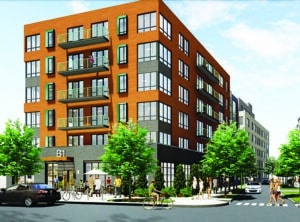
Rising construction material and labor costs are combining to create rising project costs for multifamily developers in Greater Boston. Pictured is the 191-unit Willow Baker apartment and condo development approved this fall in Boston’s South Bay. Image courtesy of PCA
The recent surge in inflation is starting to effect construction of multifamily housing in Massachusetts, forcing some developers to put projects on hold or revamp their financial assumptions amid skyrocketing materials and labor costs.
Hardest hit has been multifamily housing, particularly affordable housing projects reliant on federal and state subsidies, leading to concerns about future construction trends amid a growing housing shortage across the state and nation.
“It’s a huge concern these days,” Clark Ziegler, executive director of the Massachusetts Housing Partnership, said of rising prices for just about all construction-related items.
Ziegler, whose quasi-public entity provides financing for affordable housing projects in the state, said many affordable housing agreements include 5 percent contingency “buffers” in case of rising construction costs. But construction prices are rising so fast, sometimes even those worst-case contingency plans are rendered obsolete by the time construction is set to begin.
“It just means it blows up the numbers,” said Ziegler. “Inflation is putting a strain on everything.”
And if interest rates start to rise soon, as the Federal Reserve Board recently indicated it will do starting next year, the price of construction will only rise even more, Ziegler warned.
“That would be a double whammy,” he said of a combined inflation and interest rate hit.
Larry Curtis, president and managing partner at Boston-based Winn Development, said higher construction prices mean government subsidies for affordable-housing projects have to increase just to keep pace.
Curtis, whose company has built or renovated thousands of multifamily-housing units over the years, said affordable housing developers can’t raise rents to offset inflation, since many subsidy agreements with federal and state governments tie rents to the median income of future renters.
“In order to pencil out inflation, it’s simple: You need more government subsidies,” said Curtis, noting his construction costs have risen anywhere from 10 percent to 20 percent in recent months, when the price of land, materials and labor are included.
Drawbacks to New Sites
It’s not just affordable-housing advocates and developers feeling the pinch.
Sal Lupoli, chief executive of the Lawrence-based, market-rate developer Lupoli Cos., said rising costs have “definitely become a huge constraint.”
To offset spiking construction costs and to keep apartment rents competitive, Lupoli said his company has decided to proceed with “backburner” projects on land that it already owns, instead of searching for new development sites.
As a result, it’s moving ahead earlier than expected with the second phase of its Riverwalk Lofts development in Lawrence, adding hundreds of additional market-rate rental units at the site.
“The cost of land has just gotten too expensive,” Lupoli said.
Lupoli also estimates his labor costs are up 30 to 40 percent.
“It’s become like an auction for workers,” he said.
Meanwhile, material costs have also risen for products such as plywood, with prices for 4-foot-by-8-foot sheets soaring from $16 pre-pandemic to about $70 today, Lupoli said.

Developer Chestnut Hill Realty is only doing preliminary construction work on its Hancock Village development in Brookline amid uncertainty in labor and materials costs. Image courtesy of Chestnut Hill Realty
Can Renters Eat Cost Hikes?
According to the U.S. Bureau of Labor Statistics, overall inflation was running at about 6.8 percent for the year ending in November. Energy prices were up a whopping 33 percent over the same period, while commodities were up by 9.4 percent, food up by 6.1 percent and transportation services up by about 4 percent.
Many commodity prices, such as for lumber and steel, were already surging in the months preceding the onset of the pandemic in early 2020.
But the Associated General Contractors of America reports the pandemic and subsequent supply chain woes exacerbated those inflationary trends, leading to a nearly 30 percent jump in construction costs since the onset of the pandemic.
“Price increases have been incredible and today they’re higher than I’ve seen them in 30 years,” said James Kirby, chief executive of Commercial Construction Consulting, a development manager and advisor to companies. “There’s so much uncertainty. There seems to be no relief in sight.”
So far, Kirby said, investors are continuing to pump huge amounts of money into multifamily projects.
“There’s plenty of capital out there,” he said. “The demand for housing is still strong.”
But Edward Zuker, chief executive of Chestnut Hill Realty, said he’s sensing growing unease within financial circles over rising costs, even after months where big investors had turned to real estate projects as a hedge against uncertainty during the pandemic’s tumult.
“A lot of institutional [lenders] are getting nervous about inflation,” he said.
Until recently, demand for housing was so high in Massachusetts that developers and lenders alike assumed higher construction costs could be passed on to renters. But now some aren’t so sure.
At Chestnut Hill Realty, the firm is hedging its bets regarding its mixed-use Hancock Village project in Chestnut Hill, where Zuker said his company expects to eventually build an additional 48 rental units.
The firm plans to proceed with preliminary work at the site, such as putting in septic systems and some foundations of buildings. But it’s holding off on seeking final construction bids for perhaps a year, Zuker said. The reason: Uncertainty over costs.
“You tell me how you price things out three years from now,” he says. “It’s a very challenging time.”





